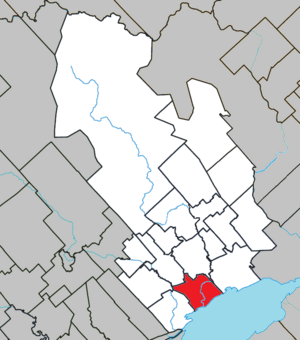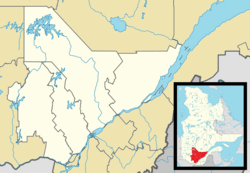Louiseville facts for kids
Quick facts for kids
Louiseville
|
|
|---|---|
|
City
|
|

City hall
|
|
| Motto(s):
Excellence et Harmonie
("Excellence and Harmony") |
|

Location within Maskinongé RCM.
|
|
| Country | |
| Province | |
| Region | Mauricie |
| RCM | Maskinongé |
| Settled | 1714 |
| Constituted | December 31, 1988 |
| Area | |
| • Total | 63.40 km2 (24.48 sq mi) |
| • Land | 62.59 km2 (24.17 sq mi) |
| Population
(2011)
|
|
| • Total | 7,517 |
| • Density | 120.1/km2 (311/sq mi) |
| • Pop 2006-2011 | |
| • Dwellings | 3,694 |
| Time zone | UTC−5 (EST) |
| • Summer (DST) | UTC−4 (EDT) |
| Postal code(s) |
J5V
|
| Area code(s) | 819 |
| Highways |
|
Louiseville is a town in the Mauricie region of Quebec, Canada. It is located near the mouth of the 'Rivière-du-Loup' river. You can find it on the north shore of Lac Saint-Pierre.
Louiseville is connected to two towns in Europe: Soissons in France and Cerfontaine in Belgium. This is called "twinning."
Contents
History of Louiseville
Early Settlement and Land Ownership
The area where Louiseville is today was once part of a large land grant called "la Seignorie Rivière-du-Loup." This special land system was set up in 1665 by a leader named Jean Talon. In 1672, the land was given to Charles Dugey Rozoy-de-Mannereuil, an officer in a special army group called the Carignan-Salières Regiment. For a while, the land was also known as Rivière-Mannereuil.
Changing Names and New Communities
In 1714, a religious group called the Récollets started a mission here. They named it after Anthony of Padua. Later, in 1722, a group of nuns called the Ursulines owned the land. They tried to change the name to Saint-Antoine-de-la-Rivière-Saint-Jean. However, people still called the settlement Rivière-du-Loup or Rivière-du-Loup-en-Haut, after the land grant or the local river.
In 1816, the town got its first post office. In 1845, the area officially became the Parish Municipality of Rivière-du-Loup-en-Haut. It was briefly stopped in 1847 but started again in 1855. This time, it was called Saint-Antoine-de-la-Rivière-du-Loup.
Becoming Louiseville
In 1878, the main part of the settlement became its own village, called the Village Municipality of Rivière-du-Loup. Just one year later, in 1879, its name was changed to Louiseville. This was done to avoid confusion with another town named Rivière-du-Loup in a different part of Quebec. The new name, Louiseville, was chosen to honor Princess Louise, Duchess of Argyll. She was the third daughter of Queen Victoria and had planned to visit the Mauricie region that year.
On January 1, 1989, the parish and village areas joined together again. They officially became the Town of Louiseville.
Population and Language
Understanding Louiseville's Population
In 2021, the population of Louiseville was 7,340 people. These people lived in 3,659 homes. This was a small increase of about 2.6% from its population of 7,152 in 2016. The town covers a land area of about 62.59 square kilometers. This means there were about 117.3 people living in each square kilometer in 2021.
Mother Tongue in Louiseville
When we talk about "mother tongue," we mean the first language someone learned at home. In Louiseville:
- About 97.6% of people speak French as their first language.
- About 0.9% of people speak English as their first language.
- About 0.6% of people speak both English and French as their first language.
- About 0.9% of people speak other languages as their first language.
Famous People from Louiseville
Louiseville has been home to some notable individuals:
- Marcelle Ferron (1924 – 2001) was a famous Canadian painter. She was also known for her beautiful stained glass artwork.
- Pierre "Doc" Mailloux (1949 – 2024) was a well-known doctor and radio show host.
- George Henry Yale was the first Mayor of Louiseville. He was also a military officer.
See also
 In Spanish: Louiseville para niños
In Spanish: Louiseville para niños


